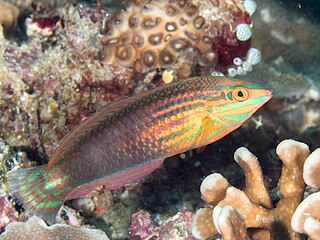
The slippery dick is a species of wrasse native to shallow, tropical waters of the western Atlantic Ocean.

The puddingwife wrasse, Halichoeres radiatus, is a species of wrasse native to the western Atlantic Ocean from North Carolina to Bermuda, through the West Indies and Gulf of Mexico, to offshore islands of Brazil, being absent from Brazilian coastal waters. It can be found on reefs at depths from 2 to 55 m, with younger fish up to subadults being found in much shallower waters from 1 to 5 m. This species can reach 51 cm (20 in) in total length, though most do not exceed 40 cm (16 in). This species is of minor importance to local commercial fisheries and can be found in the aquarium trade.

Halichoeres, commonly called wrasses, are a genus of fish in the family Labridae found in the Atlantic, Indian and Pacific Oceans.
The triplespot wrasse, also known as the white wrasse, is a species of wrasse native to the western Indian Ocean from South Africa to the Maldives and Mauritius. This species prefers areas of sandy substrates around reefs and can be found at depths from 15 to 56 m. It can reach 9.5 cm (3.7 in) in total length.

The pastel-green wrasse, also known as the black-blotched rainbowfish, black=blotched wrasse, dark-blotch wrasse or green-spotted wrasse, is a species of wrasse native to the central western Pacific Ocean. It can be found on coral reefs and the surrounding areas at depths from the surface to 10 m (33 ft). Its coloration varies depending upon the habitat in which it occurs, ranging from bright green in fish living in areas with heavy algal growth to pale or with dark bars for those inhabiting rubble areas. This species can reach 19 cm (7.5 in) in standard length. It is of minor importance to local commercial fisheries and can be found in the aquarium trade.
The longfin fairy wrasse, also known as the social wrasse, is a species of wrasse from the western Indian Ocean from the Red Sea to South Africa, though questionable claims have been made for its occurrence out to the western Pacific. It inhabits coral reefs at depths of 3 to 43 m. This species can reach a total length of 7.5 cm (3.0 in). It can be found in the aquarium trade.

The yellowhead wrasse is a fish species belonging to wrasse family native to shallow tropical waters in the Caribbean Sea and western Atlantic Ocean.

The red-lined wrasse, two-spotted wrasse or biocellated wrasse, Halichoeres biocellatus, is a species of wrasse native to shallow tropical waters in the western Pacific Ocean.

The black wrasse is a species of wrasse native to the eastern Pacific Ocean around Cocos Island, the Revillagigedo Islands, Tres Marias Islands, and the Galapagos. This species prefers areas with rocky bottoms at depths from 1 to 3 m. It can reach 12.5 cm (4.9 in) in total length.

The nebulous wrasse is a species of wrasse native to the Indian Ocean and the western Pacific Ocean. It can be found in groups at depths from 1 to 40 m on reef flats. This species feeds on fish eggs and benthic invertebrates, including crabs, sea urchins, ophiuroids, polychaetes, sponges and mollusks. Its coloration varies, ranging from brown to dark green. This species can reach 12 cm (4.7 in) in total length. It can be found in the aquarium trade.

Halichoeres maculipinna, the clown wrasse, is a species of tropical fish that lives throughout the Caribbean Sea and adjacent parts of the western Atlantic Ocean. It is a carnivorous, multi-colored wrasse that is common throughout its range.
The Weed wrasse, also known as Schwatz's wrasse or the seagrass wrasse, is a species of wrasse native to the Pacific ocean from Sumatra to Solomon Islands. It can be found in groups at depths from 1 to 4 m in seagrass beds and coral reefs. This species can reach 12 cm (4.7 in) in total length. Body is oval, rather elongated and laterally compressed. Adults are green and pinkish.

Halichoeres cosmetus, or the adorned wrasse, is a species of salt water wrasse the Indian Ocean from South Africa north to Yemen, including Socotra and east to western Thailand.

Halichoeres leucoxanthus, commonly called the Canarytop wrasse, Whitebelly wrasse, or Lemon meringue wrasse, is a fish species in the wrasse family endemic to the Indian Ocean.

Halichoeres leucurus is a marine fish commonly known as greyhead wrasse. They are harmless to humans and have a size of around 9–13 cm.

Halichoeres prosopeion, commonly called the twotone wrasse, half-grey wrasse or zig-zag wrasse, is a fish species in the wrasse family native to the western Pacific Ocean.
Halichoeres richmondi, commonly called the Richmond's wrasse or chain-lined wrasse, is a fish species in the wrasse family native from the central Indo-Pacific.

Halichoeres scapularis, commonly called the Zigzag wrasse , is a fish species in the wrasse family native from the Indo-West Pacific.

The blackear wrasse is a species of wrasse, a type of fish in the family Labridae, from the warmer waters of the western Atlantic Ocean.

Halichoeres claudia, the Christmas wrasse, is a species of wrasse of the family Labridae. It is widely distributed in the southwestern Pacific, occurring from French Polynesia to the Great Barrier Reef, with isolated populations in the Indian Ocean. This species was treated as Halichoeres ornatissimus for a long time, however, genetic evidence has shown that H. ornatissimus is restricted to Hawaii, while H. claudia is widespread in the western Pacific. The species was named in honor of Claudia Rocha for her contributions to ichthyology.

















